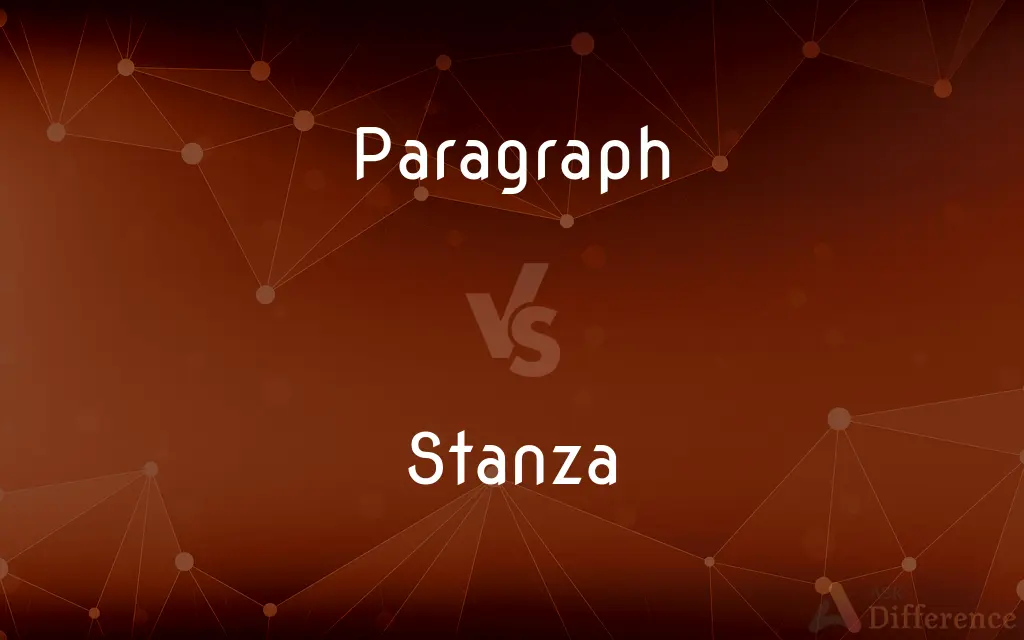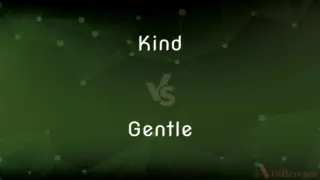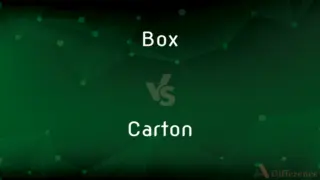Paragraph vs. Stanza — What's the Difference?
By Tayyaba Rehman — Updated on September 17, 2023
A paragraph is a distinct section of written or printed material dealing with a particular idea, usually within articles, essays, or reports. A stanza is a set of lines in a poem, grouped together by meter, rhyme, or thought.

Difference Between Paragraph and Stanza
Table of Contents
ADVERTISEMENT
Key Differences
A paragraph is a unit of writing that consists of one or more sentences. It is commonly used in essays, reports, and articles to present information, argument, or description in a clear and organized manner. A stanza, on the other hand, is a group of lines in a poem that form a unit. Unlike a paragraph, a stanza is more likely to be defined by its form and meter rather than its content.
Paragraphs serve as the building blocks of prose, guiding the reader through the text by providing breaks that organize thoughts or arguments. Stanzas serve a similar purpose in poetry. They give structure to the poem, but they also have a rhythmic or thematic function that is intrinsic to the art form. Unlike paragraphs, stanzas can have a prescribed rhyme scheme or meter.
In a paragraph, the first sentence often introduces the main idea, followed by supporting sentences and sometimes a concluding sentence. Stanzas don't have such a strict formula but are instead governed by the specific form of the poem they are part of. For example, a Shakespearean sonnet will have a particular stanzaic structure that varies significantly from a limerick.
One major difference between paragraphs and stanzas is their aesthetic function. A paragraph is mainly utilitarian and seeks to convey information in a straightforward manner. A stanza, however, often serves an aesthetic or emotional purpose. It can create a mood, build tension, or provide a musical quality to the poem. While paragraphs are concerned with clarity and coherence, stanzas often deal with emotional resonance and lyrical beauty.
Comparison Chart
Form
Prose
Poetry
ADVERTISEMENT
Structure
Sentences
Lines
Function
Organize thoughts or arguments
Provide rhythm, rhyme, or theme
Common Elements
Topic sentence, supporting sentences
Meter, rhyme scheme
Aesthetic Role
Utilitarian, clear
Emotional, lyrical
Compare with Definitions
Paragraph
A paragraph serves to organize information within a larger text.
Each paragraph in the manual covers a different feature.
Stanza
A stanza often follows a particular meter.
The stanza maintains an iambic pentameter.
Paragraph
A paragraph is a group of sentences that convey a single idea.
The first paragraph of the article introduces the problem.
Stanza
A stanza is a unit of lines in a poem.
The first stanza sets the tone for the entire poem.
Paragraph
A paragraph is the basic unit of composition in writing.
This essay consists of five paragraphs.
Stanza
A stanza can have a specific rhyme scheme.
The stanza follows an AABB rhyme scheme.
Paragraph
A paragraph can be a stand-alone piece of writing.
The author wrote a one-paragraph summary of the book.
Stanza
A stanza may vary in length depending on the form.
The stanza in this haiku is just three lines long.
Paragraph
A distinct division of written or printed matter that begins on a new, usually indented line, consists of one or more sentences, and typically deals with a single thought or topic or quotes one speaker's continuous words.
Stanza
A stanza can function thematically within a poem.
The third stanza introduces a new theme.
Paragraph
A paragraph (from the Ancient Greek παράγραφος, parágraphos, "to write beside") is a self-contained unit of discourse in writing dealing with a particular point or idea. A paragraph consists of one or more sentences.
Stanza
In poetry, a stanza (; from Italian stanza [ˈstantsa], "room") is a grouped set of lines within a poem, usually set off from others by a blank line or indentation. Stanzas can have regular rhyme and metrical schemes, though stanzas are not strictly required to have either.
Paragraph
A mark ( ¶ ) used to indicate where a new paragraph should begin or to serve as a reference mark.
Stanza
One of the divisions of a poem, composed of two or more lines usually characterized by a common pattern of meter, rhyme, and number of lines.
Paragraph
A brief article, notice, or announcement, as in a newspaper.
Stanza
A unit of a poem, written or printed as a paragraph; equivalent to a verse.
Paragraph
To divide or arrange into paragraphs.
Stanza
(architecture) An apartment or division in a building.
Paragraph
A passage in text that starts on a new line, the first line sometimes being indented, and usually marks a change of topic.
Stanza
(computing) An XML element which acts as basic unit of meaning in XMPP.
Paragraph
(originally) A mark or note set in the margin to call attention to something in the text, such as a change of subject.
Stanza
(broadcasting) A segment; a portion of a broadcast devoted to a particular topic.
Paragraph
A brief article, notice, or announcement, as in a newspaper.
Stanza
(sports) A period; an interval into which a sporting event is divided.
Paragraph
(computing) An offset of 16 bytes in Intel memory architectures.
Stanza
A number of lines or verses forming a division of a song or poem, and agreeing in meter, rhyme, number of lines, etc., with other divisions; a part of a poem, ordinarily containing every variation of measure in that poem; a combination or arrangement of lines usually recurring, whether like or unlike, in measure.
Horace confines himself strictly to one sort of verse, or stanza, in every ode.
Paragraph
To sort text into paragraphs.
Stanza
An apartment or division in a building; a room or chamber.
Paragraph
To publish a brief article, notice, or announcement, as in a newspaper.
Stanza
A fixed number of lines of verse forming a unit of a poem
Paragraph
Originally, a marginal mark or note, set in the margin to call attention to something in the text, e. g., a change of subject; now, the character
Paragraph
A distinct part of a discourse or writing; any section or subdivision of a writing or chapter which relates to a particular point, whether consisting of one or many sentences. The division is sometimes noted by the mark
Paragraph
A brief composition complete in one typographical section or paragraph; an item, remark, or quotation comprised in a few lines forming one paragraph; as, a column of news paragraphs; an editorial paragraph.
Paragraph
To divide into paragraphs; to mark with the character
Paragraph
To express in the compass of a paragraph; as, to paragraph an article.
Paragraph
To mention in a paragraph or paragraphs
Paragraph
One of several distinct subdivisions of a text intended to separate ideas; the beginning is usually marked by a new indented line
Paragraph
Divide into paragraphs, as of text;
This story is well paragraphed
Paragraph
Write about in a paragraph;
All her friends were paragraphed in last Monday's paper
Paragraph
Write paragraphs; work as a paragrapher
Paragraph
A paragraph often starts with a topic sentence.
The paragraph begins with a statement that catches the reader's attention.
Common Curiosities
What is a Paragraph?
A paragraph is a group of sentences in prose that deals with a specific idea or topic.
Is a Paragraph used in poetry?
Generally no, paragraphs are used in prose, not poetry.
Can a Paragraph be a single sentence?
While less common, a paragraph can technically be a single sentence if it conveys a complete idea.
What is a Stanza?
A stanza is a set of lines in a poem, often characterized by meter and rhyme.
Can a Stanza be a single line?
Yes, some poems employ single-line stanzas, but these are less common.
Do all Paragraphs have a topic sentence?
Not necessarily, but many paragraphs start with a topic sentence for clarity.
Do all Stanzas have a rhyme scheme?
No, some forms of poetry do not require stanzas to have a rhyme scheme.
Is a Stanza used in prose?
No, stanzas are specifically a feature of poetry.
How do you identify a Paragraph?
Paragraphs are often separated by indentation or white space in written text.
How do you identify a Stanza?
Stanzas are usually separated by blank lines in a poem.
Is indentation crucial for a Paragraph?
While commonly used, indentation is not absolutely necessary but aids in readability.
Can a Paragraph stand alone?
Yes, some paragraphs can stand alone, like abstracts or summaries.
Can a Stanza stand alone?
While it's part of a poem, a stanza can sometimes convey a complete thought and stand alone.
What is the purpose of a Paragraph?
The purpose of a paragraph is to organize and present information or ideas.
What is the purpose of a Stanza?
A stanza can serve various purposes like setting tone, creating rhythm, or introducing themes in a poem.
Share Your Discovery

Previous Comparison
Kind vs. Gentle
Next Comparison
Box vs. CartonAuthor Spotlight
Written by
Tayyaba RehmanTayyaba Rehman is a distinguished writer, currently serving as a primary contributor to askdifference.com. As a researcher in semantics and etymology, Tayyaba's passion for the complexity of languages and their distinctions has found a perfect home on the platform. Tayyaba delves into the intricacies of language, distinguishing between commonly confused words and phrases, thereby providing clarity for readers worldwide.














































